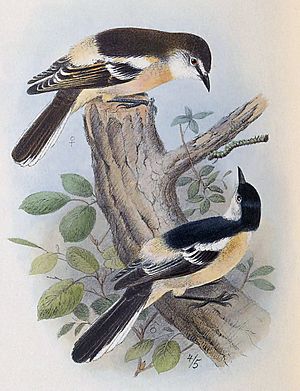Norfolk triller facts for kids
Quick facts for kids Norfolk triller |
|
|---|---|
 |
|
| Illustration by Henrik Gronvold | |
| Conservation status | |
| Scientific classification |
|
| Kingdom: | Animalia |
| Phylum: | Chordata |
| Class: | Aves |
| Order: | Passeriformes |
| Family: | Campephagidae |
| Genus: | Lalage |
| Species: | |
| Subspecies: |
L. l. leucopyga
|
| Trinomial name | |
| Lalage leucopyga leucopyga (Gould, 1838)
|
|
The Norfolk triller (Lalage leucopyga leucopyga) was a small passerine bird. Passerine birds are often called "perching birds" or "songbirds." This bird belonged to the cuckooshrike family, Campephagidae. It was a type of long-tailed triller that is now extinct. This special bird lived only on Norfolk Island, which is an Australian territory. Norfolk Island is located in the Tasman Sea, between Australia and New Zealand. We don't know much about how it lived.
Contents
What the Norfolk Triller Looked Like

The Norfolk triller looked a lot like other kinds of long-tailed trillers. However, it was a bit bigger. It also had more of a creamy-yellow color on its belly and bottom. The white tips on its outer tail feathers were also wider.
Life Cycle and Habits
How the Norfolk Triller Reproduced
Norfolk trillers were known to breed in September. They would lay eggs in December and February. Their nests were like shallow cups. They built these nests using things like lichen, moss, and plant roots. They would line the inside with softer materials. Usually, a female triller would lay two eggs at a time.
Why the Norfolk Triller Disappeared
The last time anyone saw a Norfolk triller was in 1942. This bird became extinct because of two main reasons. One reason was predation, which means being hunted. Black rats likely hunted the trillers. The other reason was the loss of their home. People cleared away much of Norfolk Island's native rainforest, which was the triller's habitat.
Images for kids



